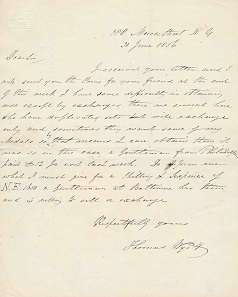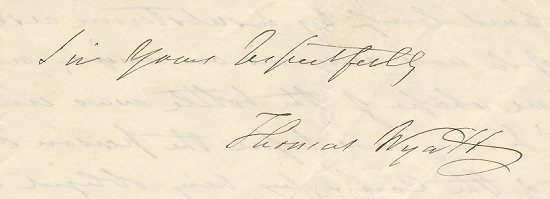08-08-2016 – 12-08-2016
Handwritten letters by forger Thomas Wyatt
Six 1856 Letters by Legendary Colonial Coin Forger Thomas Wyatt to be offered at ANA
Kolbe & Fanning will be displaying for sale at the American Numismatic Association World’s Fair of Money (Booths 263 and 362), August 9-13, 2016, an exceptionally important group of six handwritten letters by the notorious forger Thomas Wyatt.
The letters, all of which pertain to Wyatt’s creation of struck copies of early American silver coins and related fantasy pieces, were written between June and August 1856. The letters illuminate Wyatt’s methods of salesmanship and demonstrate the degree to which he was willing to falsify the provenances of his “coins.” Most importantly, perhaps, are his adamant and firm statements denying that his offerings were counterfeit or otherwise fraudulent.
Letter of June 20, 1856.
The group of letters begins with a 20 June 1856 missive asking the recipient to “inform me what I must give for a shilling & sixpence of N.E. 1650 a gentleman at Baltimore has them and is willing to sell or exchange.” A letter dated 5 July mentions that Wyatt’s unnamed source “has got the coin of the ‘Good Samaritan coined in Massachusetts,’” and asks about it. This famous fantasy piece is discussed repeatedly in the following letters. A remarkable letter dated 14 July states that “As soon as I receive the Good Samaritan piece I will enclose it to you with their price and you can do as you please about keeping it.” It also claims that “a widow lady of Chambersburg has 6 of the pine tree money pennies in a collection belonging to her late husband a Gentleman assures me he can obtain them for me she wishes to sell the collection I have requested to know particulars.” The letter mentions Jeremiah Colburn, the Boston numismatist who would publically condemn the pieces as counterfeit by August.
By late July, accusations are beginning to be made and Wyatt is feeling the heat. In a letter dated 28 July, he states, “As to the Pine Tree Money being Counterfeit I believe no such thing.” Referring to the imaginary “Chelsea Hoard” from which his trove of these pieces allegedly derived, Wyatt writes, “I saw & examined the bottle &c myself with many others and they all pronounced them genuine, many of them were stuck together in a hard lump by a substance resembling pitch some of it now remains on mine, and the antique shape of the bottle was unlike any thing I ever saw before.” He further claims that the N.E. coinage he offered came from the collection of Robert Gilmore.
On 7 August, Wyatt writes, “I have not received the Good Samaritan till this morning’s mail and I enclose it for your approval.” He asks for $7 for the coin, claiming that he will only be breaking even by such a transaction. He notes that “Mr Colburn requested as soon as I received it I would send it to him,” but Wyatt demurs. He alludes to further treasures to come from the collection at Chambersburg, including “2 Lord Baltimore shillings as good as new.” By the 12th of August, Wyatt is in defensive mode, writing, “Whatever you may be disposed to think, I have acted justly to you in every point and that man does not live that can accuse me of the reverse without slander & falsehood but there is a clique here that what they cannot obtain by fair means they will by defamation and trickery.” He adds that “you are quite mistaken about the coins being spurious metal, we tried them here in Nitric Acid and they were pronounced good silver.”
Signature of Thomas Wyatt.
All six letters are clearly signed by Wyatt and are in near fine condition. This extraordinary archive of material pertaining to one of the more audacious and famous numismatic frauds of the nineteenth century will be the highlight of Kolbe & Fanning’s 2016 ANA Convention offerings. They are on display at Booths 263 and 362 or write David Fanning for more information.
For more information on the offers of Kolbe & Fanning go to their website.





